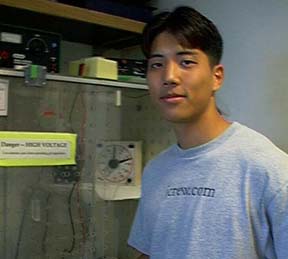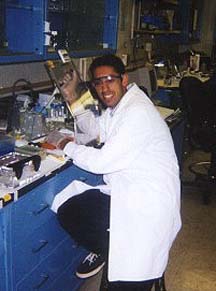John Jin Kim

John plans to alter the specificity of a well-characterized enzyme (IDH) from its natural substrate to a close relative (IPM) by using a process called directed evolution via random mutagenesis. Challenging a holy grail in biochemistry, John will attempt to change the specificity of the enzyme without losing its catalytic power. Although past attempts at rational protein design have produced only limited success, random mutagenesis is a promising new technique in which evolution that normally takes millions of years is compacted into a few months. John’s research will lead to […]
Jonathan Clingan

Human cytomegalovirus (HCMV) is a member of the herpesvirus family, and a major cause of disease in people with compromised immune systems, particularly AIDS patients. Through the course of Jonathan’s research, several viral mutants that exhibit a severely attenuated ability to grow in cell culture have been identified. Jonathan will study the function of a protein encoded by open reading frame (ORF) UL 21, in which a mutation causes significantly attenuated growth. Through the process of recombination, the protein can be labeled using an epitope tag. Using antibodies that are […]
Dang Khoa Lam

Under the guidance of Dr. Richard Harland and two postdoctoral fellows, Dr. Timothy Grammer and Dr. Mustafa Khokha, Dang will study the novel grinch mutation that affects the lymphatic system of the frog Xenopus tropicalis. Like humans, frogs have a lymphatic system which drains fluids from tissues back to the bloodstream. The lymphatic system influences the course of many human diseases, from lymphedema to tumor metastasis; and currently little is known about the molecular basis of lymphatic development. Dang’s efforts will ultimately result in the characterization and identification of the […]
Christina Marie Hamilton

Marine-atmosphere gas exchange plays a major role in the global carbon cycle. A key parameter of oceanic CO2 uptake and sequestration is the biological carbon pump (BCP). The BCP is composed of planktonic organisms that fix CO2 in photosynthesis, converting it to food and tissue. The biomass of these organisms turns over about once every week, exporting the carbon they contain away from the ocean-atmospheric interface to greater oceanic depths as they are consumed and expelled in the form of particulate organic carbon aggregates. This process, known as sedimentation, is […]
Natalia Oleg Glebova

Natalia’s Senior Honors Thesis in Biochemistry and Molecular Biology evolves out of her passionate commitment to contribute to the restoration of the environment, a matter she believes should be a priority for modern society. She will be investigating the molecular mechanisms of selenite detoxification in the bacterium Bacillus subtilis, focusing on the function of the proteins thioredoxin and thioredoxin reductase in toxic metal biotransformation. The results of her research will lead to improved bioremediation of selenite-contaminated soil and water and, more broadly, to a better understanding of the practical use […]
Umair Khan

For his Senior Honors Thesis in Molecular & Cell Biology, Umair will investigate the effects of a protein co-factor on the interactions between RNase P ribozyme and a model mRNA substrate. His research will deepen our understanding of how the protein co-factor affects the sequence-specific ribozyme’s structure and activity as it cleaves an mRNA encoding thymidine kinase of herpes simplex virus 1. By revealing how the ribozyme interacts with the viral mRNA, Umair will provide insight into the engineering of sequence-specific ribozymes as antiviral therapeutic agents, with important applications for […]
Raul Clavijo

The basic purpose of Raul’s study, which will form the basis for his senior honors thesis in Molecular and Cell Biology, is to understand a characteristic of Salmonella enteritidis (S. enteritidis) that allows it to be the only bacterium to contaminate chicken eggs routinely. The specific objective is to determine the role of a particular set of genes, found in the cadAB operon, in conferring egg albumen/white resistance to S. enteritidis. Preliminary data has shown that a mutant S. enteritidis, with an interruption that disables the cadAB operon, is more […]
Yoon Han

As part of Professor Shaowen Baos lab, Yoon will expand our understanding of the influence of sensory input on information processing during an epoch of early development known as the critical period. At the behavioral level, he will investigate how early experience of single-frequency tone pips influences frequency discrimination ability in rats. At the physiological level, he will examine the auditory cortex (A1) of tone-exposed rats to extract response properties of the cortical neurons, such as the characteristic frequency, spontaneous firing rate, maximum firing rate, and tuning bandwidth. At the […]
Elizabeth Nicole Wilcut

Elizabeth plans to design, construct and test a prototype of a low temperature refrigerator, in order to demonstrate an efficient and simple method for cooling to temperatures below 1 Kelvin. Currently, dilution refrigerators are used to achieve such low temperatures, a technology that is complicated, expensive and experimentally demanding. By pioneering the use of a refrigerator that uses a flowing electrical current through superconductor junctions, Elizabeth’s prototype will improve on the cooling power of some preliminary electronic refrigerators by more than four orders of magnitude and create a technology that […]
John Weedin

A double major in Molecular & Cell Biology and History, John intends to investigate the function of polysialic acid (PSA) on the cellular membranes of cancer cells. Polysialic acid is a relatively long, negatively charged sugar polymer composed only of sialic acid monomers. While the role of polysialic acid in neural and fetal cells has been well studied, information regarding its role in tumor cells has not. John hypothesizes that the long molecule disrupts the cell-cell interactions that prevent uncontrolled cell division, allowing tumor cells to rapidly multiply and expand. […]